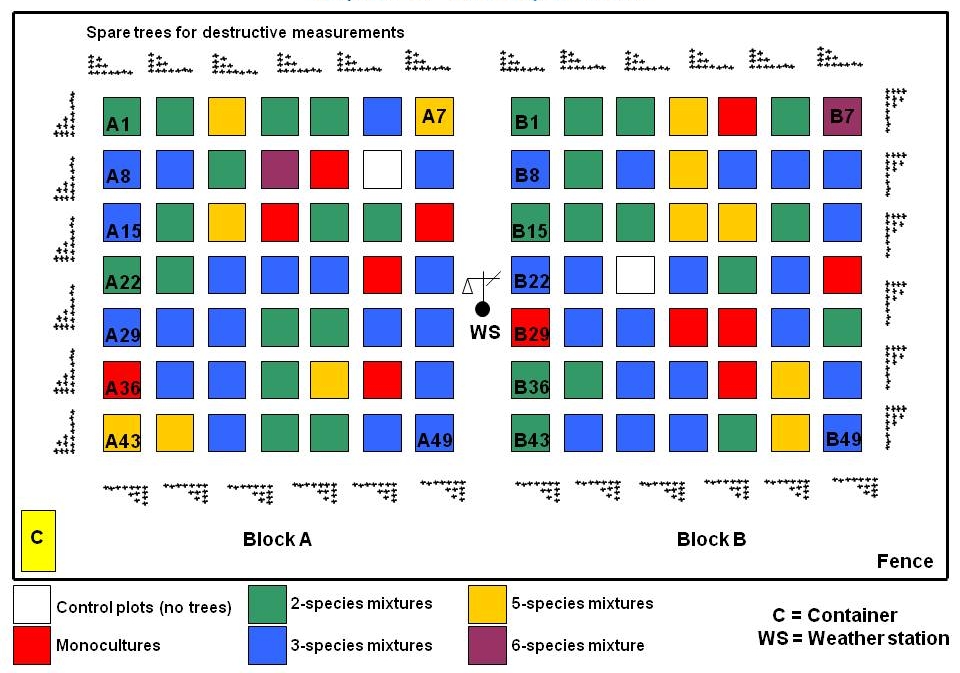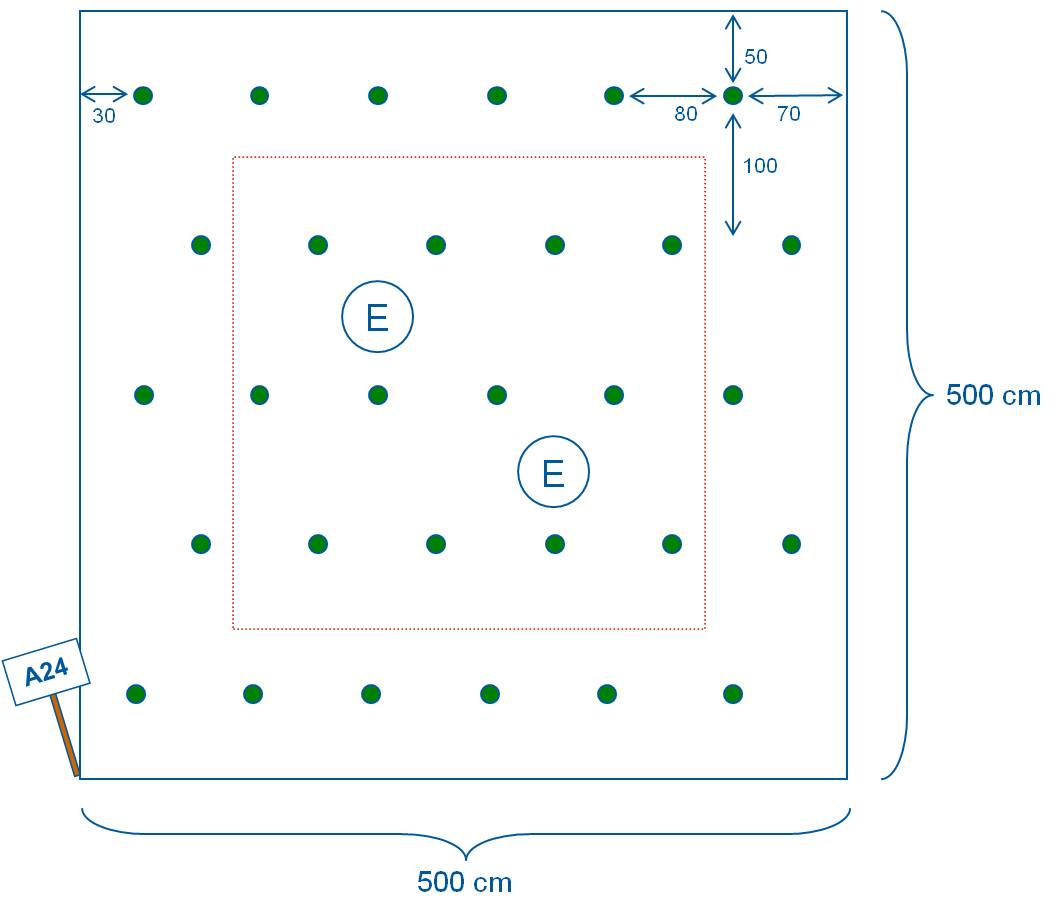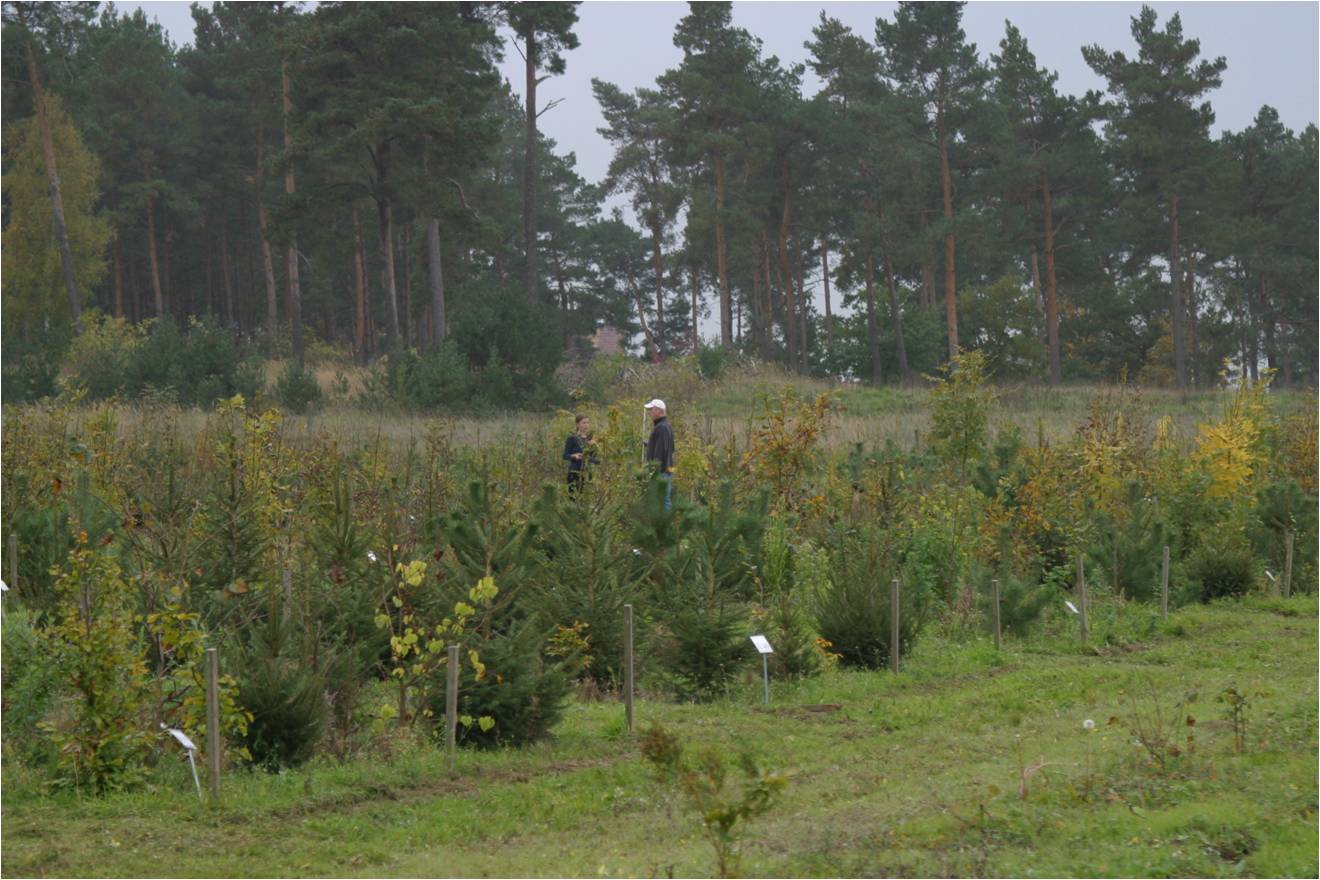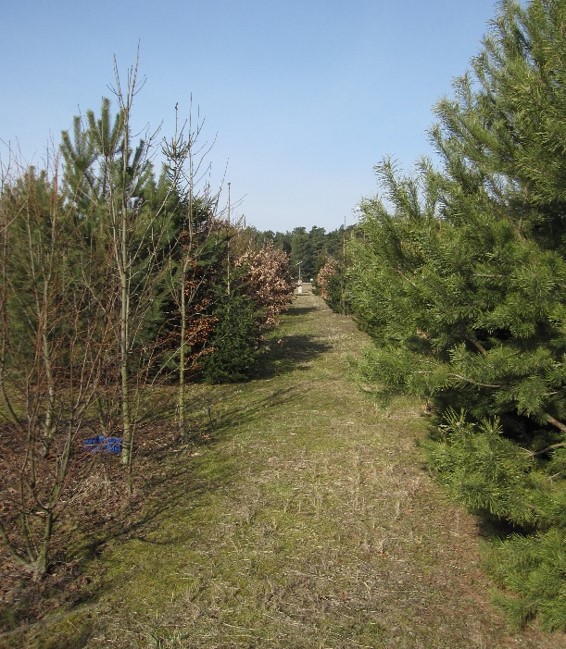The Kreinitz experiment was established in 2005 to study the effect of tree species diversity on productivity and belowground processes.
Design
The experiment consists of 2 blocks that contain 49 plots each. All possible 1, 2, 3, 5, and 6 species combinations were planted, and a control plot without trees was added. The plots are randomly distributed within each block.
In a plot, 30 trees were planted on rows (1 m between rows, 0.8 m between trees in a row); the different species were distributed randomly within a plot. Two exclosures of stainless steel were installed in every plot to exclude tree roots and mycorrhiza.
 |
 |
| 2 blocks with 49 plots each |
a plot with 30 trees planted on rows |
Site characteristics
| location |
Zeithain |
| former land use |
arable field until 1990s, abandoned till 2005 |
| altitude |
110-120 m |
| soil type |
humic cambisol on a bedrock of sand and gravel |
| area |
0.75 ha |
| no of plots |
98 |
| plot size |
5 m x 5 m |
| no of trees planted |
2 880 |
| planting date |
fall 2005 |
| diversity variables |
species richness
functional diversity |
| diversity gradient |
0, 1, 2, 3, 5, 6 sp.
decomposition rate |
| size species pool |
6 |
| species pool |
Fagus sylvatica, Fraxinus excelsior, Picea abies, Pinus sylvestris, Quercus petraea, Tilia cordata |
| contact person |
Harald Auge |
Research
The first research goal is determining how tree species and functional diversity affect stand productivity, matter cycling, and the diversity and abundance of, e.g., herbivores, pathogens, decomposers, and mycorrhizal fungi.
The research further focuses on the after-life effects of tree diversity: how does leaf litter diversity and composition affect decomposition rate and the diversity and abundance of decomposer invertebrates and microbes.
Extra information
Send an e-mail to the contact person or explore the publications:
theses
- Kovach, K (2021) Measurements of canopy properties to reveal biodiversity-ecosystem function relationships in tree diversity experiments using UAV remote sensing. PhD thesis, University of Freiburg
- Hantsch L (2013) Tree diversity effects on species richness and infestation of foliar fungal pathogens in European tree diversity experiments. PhD thesis, Martin-Luther University Halle
- Haase JU (2009) Biodiversity and ecosystem functioning: the effects of tree and litter diversity. PhD thesis, University of Zurich
papers
- Cesarz S, Craven D, Auge H, Bruelheide H, Castagneyrol B, Gutknecht J, Hector A, Jactel H, Koricheva J, Messier C, Muys B, Brien MJO, Paquette A, Ponette Q, Potvin C, Reich PB, Scherer-Lorenzen M, Smith AR, Verheyen K, Eisenhauer N (2022) Tree diversity effects on soil microbial biomass and respiration are context dependent across forest diversity experiments. Global Ecology and Biogeography 31:872-885 - https://doi.org/10.1111/geb.13461
- Kambach S, Sadlowski C, Peršoh D, Guerreiro MA, Auge H, Röhl O, Bruelheide (2021) Foliar Fungal Endophytes in a Tree Diversity Experiment Are Driven by the Identity but Not the Diversity of Tree Species. Life 11(10): 1081 - https://doi.org/10.3390/life11101081
- Kwon T, Shibata H, Kepfer-Rojas S, Schmidt IK, Larsen KS, Beier C, Berg B, Verheyen K, Lamarque J-F, Hagedorn F, Eisenhauer N, Djukic I, TeaCompositionNetwork (2021) Effects of climate and atmospheric nitrogen deposition on early to mid-term stage litter decomposition across biomes. Frontiers in Forests and Global Change 4: 678480 - https://doi.org/10.3389/ffgc.2021.678480
- Messier C, Bauhus J, Sousa-Silva R, Auge H, Baeten L, Barsoum N, Bruelheide H, Caldwell B, Cavender-Bares J, Dhiedt E, Eisenhauer N, Ganade G, Gravel D, Guillemot J, Hall JS, Hector A, Hérault B, Jactel H, Koricheva J, Kreft H, Mereu S, Muys B, Nock CA, Paquette A, Parker JD, Perring MP, Ponette Q, Potvin C, Reich PB, Scherer-Lorenzen M, Schnabel F, Verheyen K, Weih M, Wollni M, Zemp DC (2021) For the sake of resilience and multifunctionality, let's diversify planted forests! Conservation Letters e12829 - https://doi.org/10.1111/conl.12829
- Cesarz S, Schulz AE, Beugnon R, Eisenhauer N (2019) Testing soil nematode extraction efficiency using different variations of the Baermann-funnel method. Soil Organisms 91(2): 61–72 - https://doi.org/10.25674/so91201
- Gottschall F, Davids S, Newiger-Dous T E, Auge H, Cesarz S, Eisenhauer N (2019). Tree species identity determines wood decomposition via microclimatic effects. Ecology and Evolution 9: 12113-12127 - https://doi.org/10.1002/ece3.5665
- Kambach S, Allan E, Bilodeau-Gauthier S, Coomes D A, Haase J, Jucker T, Kunstler G, Muller S, Nock C, Paquette A, van der Plas F, Ratcliffe S, Roger F, Ruiz-Benito P, Scherer-Lorenzen M, Auge H, Bouriaud O, Castagneyrol B, Dahlgren J, Gamfeldt L, Jactel H, Kandler G, Koricheva J, Lehtonen A, Muys B, Ponette Q, Setiawan N, Van de Peer T, Verheyen K, Zavala M A, Bruelheid H (2019) How do trees respond to species mixing in experimental compared to observational studies? Ecology and Evolution 9: 11254-11265 - https://doi.org/10.1002/ece3.5627
- Djukic I, Kepfer-Rojas S, Kappel Schmidt I, Steenberg Larsen K, Beier C, Berg B, Verheyen K, TeaComposition (2018) Early stage litter decomposition across biomes. Science of the Total Environment
- Grossman JJ, Vanhellemont M, Barsoum N, Bauhus J, Bruelheide H, Castagneyrol B, Cavender-Bares J, Eisenhauer N, Ferlian O, Gravel D, Hector A, Jactel H, Kreft H, Mereu S, Messier C, Muys B, Nock C, Paquette A, Parker J, Perring MP, Ponette Q, Reich PB, Schuldt A, Staab M, Weih M, Zemp DC, Scherer-Lorenzen M, Verheyen K (2018) Synthesis and future research directions linking tree diversity to growth, survival, and damage in a global network of tree diversity experiments. Environmental and Experimental Botany - doi: 10.1016/j.envexpbot.2017.12.015
- Guerrero-Ramírez NR, Craven D, Reich PB, Ewel JJ, Isbell F, Koricheva J, Parrotta JA, Auge H, Erickson HE, Forrester DI, Hector A, Joshi J, Montagnini F, Palmborg C, Piotto D, Potvin C, Roscher C, van Ruijven J, Tilman D, Wilsey B, Eisenhauer N (2017). Diversity-dependent temporal divergence of ecosystem functioning in experimental ecosystems. Nature Ecology & Evolution 1(11): 1639-1642 - doi: 10.1038/s41559-017-0325-1
- Paine CET, Amissah L, Auge H, Baraloto C, Baruffol M, Bourland N, Bruelheide H, Daïnou K, de Gouvenain RC, Doucet J-L, Doust S, Fine PVA, Fortunel C, Haase J, Holl KD, Jactel H, Li X, Kitajima K, Koricheva J, Martínez-Garza C, Messier C, Paquette A, Philipson C, Piotto D, Poorter L, Posada JM, Potvin C, Rainio K, Russo SE, Ruiz-Jaen M, Scherer-Lorenzen M, Webb CO, Wright SJ, Zahawi RA, Hector A (2015) Globally, functional traits are weak predictors of juvenile tree growth, and we do not know why. Journal of Ecology 103: 978-989 - doi: 10.1111/1365-2745.12401
- Schwarz B, Dietrich C, Cesarz S, Scherer-Lorenzen M, Auge H, Schulz E, Eisenhauer N (2015) Non-significant tree diversity but significant identity effects on earthworm communities in three tree diversity experiments. European Journal of Soil Biology 67: 17-26 - doi: 0.1016/j.ejsobi.2015.01.001
- Wurst S, Kaiser N, Nitzsche S, Haase J, Auge H, Rillig MC, Powell JR (2015) Tree diversity modifies distance-dependent effects on seedling emergence but not plant-soil feedbacks of temperate trees. Ecology 96:1529-1539 - doi: 10.1890/14-1166.1
- Alalouni U, Brandl R, Auge H, Schädler M (2014) Does insect herbivory on oak depend on the diversity of tree stands? Basic and Applied Ecology 15: 685-692 - doi: 10.1016/j.baae.2014.08.013
- Hantsch L, Bien S, Radatz S, Braun U, Auge H, Bruelheide H (2014) Tree diversity and the role of non-host neighbour tree species in reducing fungal pathogen infestation. Journal of Ecology 102, 1673-1687 - doi: 10.1111/1365-2745.12317
 |
 |
| The Kreinitz plantation in 2008 and 2013 |




